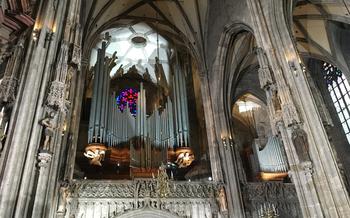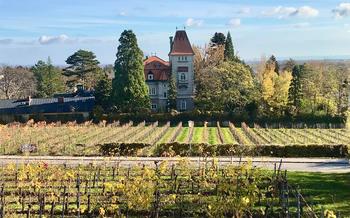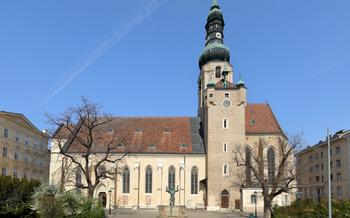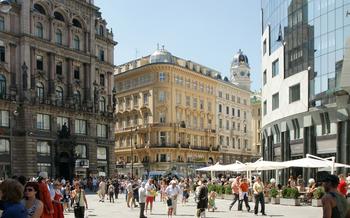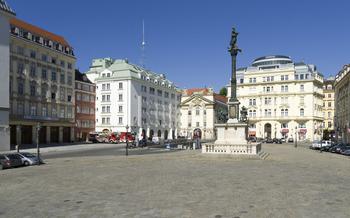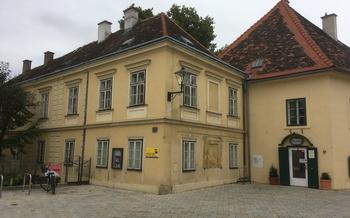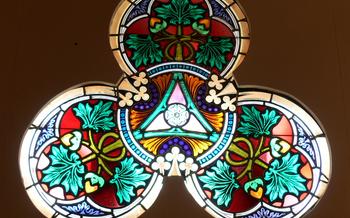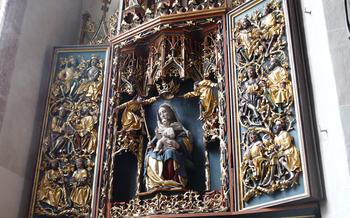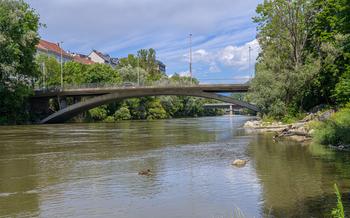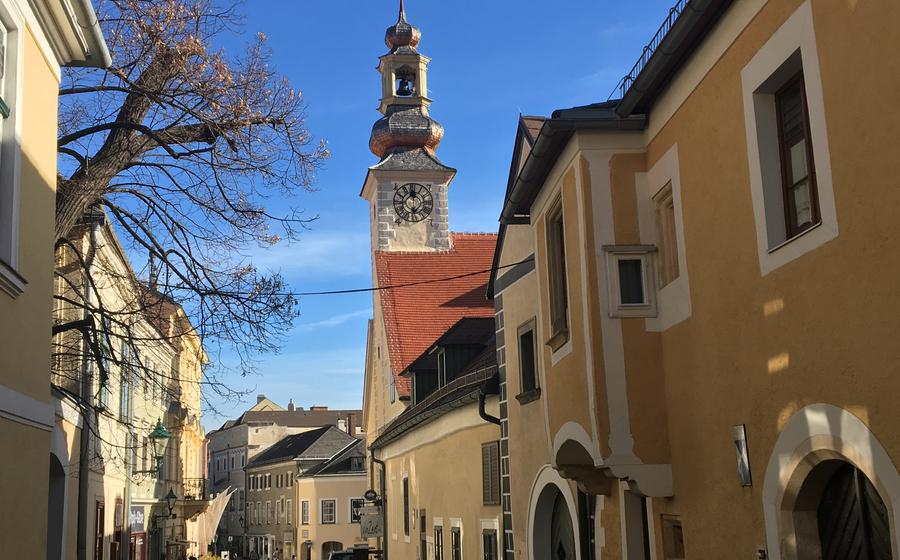
Stephansdom (St. Stephen's Cathedral)
- Atop Vienna's Skyline: St. Stephen's Cathedral
- South Tower's Secrets: An Unforgettable Ascent
- Exploring the Nave: A Journey Through History
- Crypts: Unveiling the Cathedral's Silent History
- Catacombs: A Journey into the Past
- History
- Architecture
- Artifacts
- Insider Tip: Wear Comfortable Shoes
- Roof Tour: Unveiling the Cathedral's Hidden Treasures
- Giant Organ: A Symphony of Sound
- Cathedral Treasury: A Glimpse into Ecclesiastical Splendor
- Stephansplatz: The Cathedral's Vibrant Square
- Giant's Door: A Gateway to History
- Cathedral Museum: A Journey Through Time
- Stephansdom Archaeological Park: Uncovering Hidden Layers
- Stephansdom Concerts: A Feast for the Senses
- Insider Tip: Hidden Gem – The Stephansdom Catacombs
Atop Vienna's Skyline: St. Stephen's Cathedral
Vienna's Stephansdom (St. Stephen's Cathedral) stands as a majestic testament to Gothic architecture, its towering presence dominating the city's skyline. Its 800-year-old history is a testament to its enduring significance, a history that unfolds through its intricate architecture, artistic treasures, and the panoramic vistas from its South Tower.
History: Gothic Masterpiece's 800-Year-Old Story
The cathedral's origins date back to the 12th century, when a Romanesque church stood on the site. However, it was in the 14th century that construction began on the Gothic masterpiece we see today. Over the centuries, the cathedral has undergone numerous additions and modifications, reflecting the changing tastes and needs of its time.
Architecture: Exploring the Cathedral's Unique Features
St. Stephen's Cathedral is a treasure trove of Gothic architectural elements. Its exterior boasts intricate stone carvings, delicate tracery, and soaring buttresses. The interior is equally impressive, with its lofty vaults, stained glass windows, and ornate altars.
Interior: Unveiling the Artistic Treasures Within
The cathedral's interior is a testament to the artistic prowess of its creators. The nave is lined with magnificent stained glass windows, each depicting a different biblical scene. The high altar, with its intricate carvings and gold leaf, is a masterpiece of the Gothic style.
Views: Panoramic Vistas from the South Tower
For breathtaking panoramic views of Vienna, ascend the 343 steps to the top of the South Tower. The viewing platform offers unparalleled vistas of the city, stretching from the historic center to the distant hills.
South Tower's Secrets: An Unforgettable Ascent
History buffs and architecture enthusiasts alike will be captivated by the South Tower of St. Stephen's Cathedral. Its construction, spanning the 14th and 15th centuries, reflects Vienna's evolving architectural styles and showcases the skill of master builders. Originally intended as a watchtower, the tower's role evolved over time, serving as a symbol of the city's power and resilience.
Marvel at the tower's intricate details, including the delicate tracery of its Gothic windows and the ornate carvings that adorn its façade. Take a moment to appreciate the interplay of light and shadow as the sun's rays dance across the tower's surface, casting ever-changing patterns.
The highlight of any visit to the South Tower is undoubtedly the breathtaking views from its observation deck. Ascend the 343 steps to the top, and you'll be rewarded with panoramic vistas that stretch far beyond Vienna's city limits. Gaze upon the intricate tapestry of rooftops, spires, and domes, and let the grandeur of the city envelop you.
Insider Tip: Pre-book your tickets online to avoid queues and secure a spot for your ascent. This way, you can skip the hassle and fully immerse yourself in the awe-inspiring experience that awaits you at the top of the South Tower.
Exploring the Nave: A Journey Through History
The nave of St. Stephen's Cathedral is a testament to the grandeur of Gothic architecture. As you step inside, you'll be awestruck by the soaring vaulted ceilings, intricate stained glass windows, and elegant pillars that line the central aisle. The nave is the heart of the cathedral, where countless religious ceremonies, coronations, and imperial weddings have taken place throughout history.
History
The construction of the nave began in the 14th century and was completed in the 15th century. It replaced an earlier Romanesque basilica that had stood on the site. The nave was designed to accommodate large congregations and provide a suitable space for elaborate religious processions. Over the centuries, the nave has undergone several renovations and modifications, but it retains its original Gothic character.
Architecture
The nave is a masterpiece of Gothic architecture, characterized by its pointed arches, ribbed vaults, and flying buttresses. The slender pillars that support the vaults create a sense of height and spaciousness, while the intricate tracery of the stained glass windows casts a colorful glow on the interior. The nave is also home to several impressive works of art, including the pulpit, the baptismal font, and the magnificent high altar.
Art
The nave of St. Stephen's Cathedral is adorned with a wealth of artistic treasures. The stained glass windows, created by some of the finest glassmakers of the Middle Ages, depict scenes from the Bible and the lives of the saints. The pulpit, carved from white limestone, features intricate reliefs depicting scenes from the life of Jesus. The high altar, a masterpiece of Baroque art, is made of marble, gold, and precious stones, and is adorned with statues of the Virgin Mary and the twelve apostles.
Insider Tip:
To fully appreciate the nave's architectural and artistic wonders, join a guided tour led by an expert who can provide in-depth insights into the history and significance of the various features of the nave. Guided tours are available in multiple languages and can be booked in advance or on-site.
Crypts: Unveiling the Cathedral's Silent History
Beneath the grandeur of Stephansdom, a hidden world awaits—the crypts, a silent testament to Vienna's rich history. Originally intended as a burial site for the Habsburg dynasty, these hallowed chambers house the remains of emperors, empresses, and other notable figures.
As you descend into the dimly lit crypts, a palpable sense of history envelops you. Elaborate sarcophagi line the walls, each adorned with intricate carvings and inscriptions that tell the stories of the departed. Among them lies Emperor Frederick III, whose magnificent tomb is a masterpiece of Gothic art.
Beyond the Habsburg tombs, the crypts reveal other fascinating secrets. In the Ducal Crypt, you'll find the remains of the Babenberg dynasty, Vienna's first ruling family. And in the Bishop's Crypt, you can pay your respects to the former archbishops of Vienna.
If you visit the crypts during the summer months, you'll have the chance to explore even further. During this time, additional sections of the crypts are open to the public, offering a glimpse into the lives and deaths of Vienna's past inhabitants.
Insider Tip: To make the most of your visit, consider joining a guided tour of the crypts. These tours provide fascinating insights into the history and significance of these underground chambers, bringing the stories of their occupants to life.
Catacombs: A Journey into the Past
Beneath the grandeur of St. Stephen's Cathedral lies a hidden world of history and mystery – the catacombs. These subterranean chambers, once used as burial grounds for notable figures and clergy, offer a glimpse into the past and provide a unique perspective on the cathedral's rich history.
History
The catacombs were constructed in the 14th century to alleviate overcrowding in the cathedral's cemeteries. For centuries, they served as the final resting place for archbishops, bishops, and other prominent individuals associated with the cathedral. The catacombs were expanded several times over the centuries, eventually reaching a total length of over 300 meters.
Architecture
The catacombs are a marvel of medieval engineering, constructed using a series of interconnected tunnels and chambers. The walls are lined with niches, where the deceased were laid to rest in stone coffins. The catacombs are also adorned with intricate carvings and murals, depicting religious scenes and symbols.
Artifacts
Over the centuries, the catacombs have yielded a wealth of fascinating artifacts, including jewelry, coins, and religious objects. These items provide valuable insights into the lives and customs of the people who were buried here. Visitors can view a selection of these artifacts in the cathedral's museum.
Insider Tip: Wear Comfortable Shoes
The catacombs are not easily accessible, and visitors should be prepared for uneven terrain and tight spaces. It is advisable to wear comfortable shoes and clothing for navigating the catacombs safely. Guided tours are available for those who wish to learn more about the history and significance of these hidden chambers.
Roof Tour: Unveiling the Cathedral's Hidden Treasures
The Stephansdom's roof, often overlooked by visitors, offers a unique and thrilling experience. A guided tour will take you through hidden passageways and up narrow spiral staircases to the top of the cathedral, where you'll be rewarded with breathtaking panoramic views of Vienna. From up here, you can admire the intricate details of the roof's colorful tiles, gargoyles, and spires, as well as the surrounding cityscape.
The roof tour also provides a fascinating glimpse into the cathedral's history and construction. You'll learn about the challenges faced by the builders and the techniques they used to create this architectural masterpiece. Don't miss the chance to see the Pummerin bell, Vienna's largest bell, up close.
For an unforgettable experience, time your visit to coincide with sunset. As the sun dips below the horizon, the city lights begin to twinkle, creating a magical and romantic atmosphere.
Insider Tip: Book your roof tour in advance, especially during peak tourist season, to avoid disappointment. Also, wear comfortable shoes and be prepared for some climbing.
Giant Organ: A Symphony of Sound
A Majestic Presence:
In the heart of St. Stephen's Cathedral, a musical marvel awaits—the Giant Organ. With its towering pipes and intricate design, this magnificent instrument has captivated generations with its awe-inspiring sound.
A Journey Through Time:
The Giant Organ's history is as rich as the melodies it produces. Built in the 19th century, it stands as a testament to the ingenuity and artistry of its creators. Over the years, the organ has undergone meticulous restorations, ensuring that its grandeur and functionality endure.
A Symphony of Sound:
The Giant Organ boasts an impressive array of registers and stops, allowing organists to create a vast repertoire of sounds. From the delicate shimmer of the celesta to the thunderous roar of the full organ, every note reverberates through the cathedral's hallowed halls, creating an immersive and unforgettable experience.
Insider Tip:
To truly appreciate the Giant Organ's splendor, plan your visit to coincide with one of the regular concerts or recitals held in the cathedral. Renowned organists showcase their mastery, filling the space with the captivating sounds of classical and contemporary compositions. Immerse yourself in the music and let the Giant Organ transport you to another realm.
Cathedral Treasury: A Glimpse into Ecclesiastical Splendor
Step into the hallowed halls of Stephansdom's Cathedral Treasury, a treasure trove of ecclesiastical splendor that has captivated visitors for centuries. Established in the 13th century, this awe-inspiring collection houses a dazzling array of sacred artifacts, precious relics, and opulent vestments that narrate the rich history and spiritual heritage of the cathedral.
Delve into the treasury's opulent chambers to discover an assemblage of exquisite gold and silver objects, intricately adorned with gemstones and enamel. Admire the resplendent reliquaries, adorned with intricate carvings and housing the remains of revered saints. Marvel at the collection of ecclesiastical vestments, meticulously crafted with sumptuous fabrics and shimmering embroidery, worn by high-ranking church officials during grand religious ceremonies.
Among the treasury's highlights is the exquisite Stephanus-Bursa, an ornate reliquary crafted in the 14th century to hold the relics of Saint Stephen, the cathedral's patron saint. Its intricate gold filigree and shimmering gemstones evoke a sense of reverence and awe. Don't miss the stunning collection of monstrances, elaborate vessels used to display the consecrated host during religious processions, showcasing the artistry and craftsmanship of master goldsmiths.
To fully appreciate the significance of these treasures, book a guided tour to gain exclusive insights into their history, symbolism, and the rituals associated with their use. The Cathedral Treasury offers a captivating journey through the centuries, providing a glimpse into the profound spiritual traditions that have shaped Stephansdom's legacy.
Stephansplatz: The Cathedral's Vibrant Square
A bustling hub of activity, Stephansplatz pulsates with life and energy, serving as a vibrant gathering space for locals and tourists alike. Steeped in history, the square has witnessed countless events, from lively markets and religious processions to grand celebrations. Its architectural wonders, including the majestic Stephansdom, the ornate Haas House, and the elegant Hotel Sacher, create a breathtaking backdrop for this vibrant square.
At the heart of Stephansplatz stands the Pestsäule, a monumental plague column erected in the 17th century as a tribute to those who lost their lives during the devastating plague epidemic. Intricately adorned with sculptures and reliefs, the column serves as a poignant reminder of Vienna's resilience and faith.
During the festive season, Stephansplatz transforms into a magical winter wonderland, hosting one of Vienna's most enchanting Christmas markets. The air fills with the sweet aroma of roasted chestnuts, mulled wine, and gingerbread as visitors browse the stalls adorned with twinkling lights and festive decorations. The square comes alive with the sounds of Christmas carols and the laughter of children, creating a truly unforgettable atmosphere.
Insider Tip:
To fully immerse yourself in the vibrant energy of Stephansplatz, visit during the summer months when outdoor cafés and restaurants spill onto the cobblestone streets. Indulge in a leisurely meal or simply relax with a cup of coffee while soaking up the lively atmosphere.
Giant's Door: A Gateway to History
The Giant's Door, also known as the Riesentor, is a magnificent entrance to St. Stephen's Cathedral, captivating visitors with its intricate carvings and historical significance. Step through this grand portal and be transported back in time as you uncover the stories etched in stone.
Crafted in the 15th century, the Giant's Door is a testament to the artistry and craftsmanship of the Gothic era. Its name, derived from the colossal statues flanking the doorway, hints at the door's imposing presence. These statues, representing biblical figures and historical personalities, stand as silent guardians, welcoming visitors into the cathedral's sacred space.
As you gaze upon the door's intricate carvings, you'll discover a wealth of symbolism and religious iconography. From the delicate tracery and floral motifs to the expressive figures depicted in stone, each detail holds a deeper meaning, inviting you to contemplate the spiritual and historical significance of this awe-inspiring entrance.
Take a moment to decipher the hidden symbols and inscriptions adorning the door. Look for the stonemason's mark, a unique signature left by the craftsman who created this masterpiece. Discover the subtle references to biblical narratives and allegorical representations that bring the door's stories to life.
The Giant's Door is not just an architectural marvel but also a gateway to the rich history of St. Stephen's Cathedral and Vienna itself. As you step through its threshold, you become part of a centuries-old tradition, connecting you to the countless pilgrims, worshippers, and visitors who have crossed this threshold before you.
Insider Tip: Keep an eye out for the hidden symbols and inscriptions on the Giant's Door. These subtle details offer a glimpse into the minds of the medieval craftsmen who created this masterpiece and provide a deeper understanding of the door's historical and religious significance.
Cathedral Museum: A Journey Through Time
Nestled within the heart of Stephansdom, the Cathedral Museum invites visitors on a captivating journey through the cathedral's rich history and artistic heritage. Established in the 1930s, the museum occupies the former sacristy, a magnificent space that exudes an air of reverence and intrigue.
As you step inside, you'll be greeted by a treasure trove of artifacts, artworks, and relics that tell the story of Stephansdom's evolution over the centuries. From medieval manuscripts and sculptures to stunning tapestries and goldsmith works, each exhibit offers a glimpse into the cathedral's past and the artistry that has adorned its hallowed halls.
One of the museum's highlights is the Stephansdom Model, a meticulously crafted miniature replica of the cathedral that showcases its intricate architectural details and grandeur. This model provides a fascinating perspective on the cathedral's construction and allows visitors to appreciate its beauty from a unique vantage point.
Another must-see exhibit is the collection of reliquaries, which house the remains of saints and other religious figures. These ornate containers, adorned with precious metals and jewels, reflect the deep devotion and reverence accorded to these holy relics.
For those seeking a deeper understanding of the cathedral's history, the museum offers a range of guided tours that delve into specific themes and provide expert insights into the significance of the artifacts on display. These tours offer a personalized and enriching experience, allowing visitors to uncover the hidden stories behind the museum's treasures.
Before departing, be sure to visit the museum shop, where you can find a variety of souvenirs and mementos to commemorate your visit to Stephansdom. From books and postcards to replicas of the cathedral's artifacts, there's something for every visitor to cherish.
Whether you're a history buff, an art enthusiast, or simply seeking a deeper connection to Stephansdom, the Cathedral Museum promises a rewarding experience that will leave you with a newfound appreciation for this iconic Viennese landmark.
Stephansdom Archaeological Park: Uncovering Hidden Layers
Beneath the grandeur of Stephansdom lies a hidden treasure trove of history and archaeology – the Stephansdom Archaeological Park. Descend into this subterranean world and embark on a journey through time, uncovering the ancient foundations and remnants of long-lost structures.
History: A Buried Past Revealed
The Stephansdom Archaeological Park unveils the fascinating history of the cathedral and its surroundings. Excavations have uncovered the remains of Roman settlements, early Christian churches, and medieval fortifications, providing a glimpse into Vienna's rich and layered past.
Architecture: Ancient Ruins and Foundations
Explore the park's ancient ruins and foundations, remnants of structures that once stood tall. Admire the preserved sections of the Roman city wall, the foundations of early Christian churches, and the remains of medieval buildings, each telling a unique story of Vienna's architectural heritage.
Artifacts: Treasures from the Depths
As you delve deeper into the archaeological park, discover a treasure trove of artifacts unearthed during excavations. These relics, ranging from pottery shards and coins to jewelry and tools, offer tangible connections to the lives and cultures of Vienna's past inhabitants.
Insider Tip: Guided Tour for an In-Depth Exploration
To fully immerse yourself in the history and significance of the Stephansdom Archaeological Park, join a guided tour. Knowledgeable guides will lead you through the site, providing expert insights and anecdotes that bring the past to life, making your visit a truly enriching experience.
Stephansdom Concerts: A Feast for the Senses
Stephansdom is not only a magnificent architectural masterpiece but also a vibrant center for music and the arts. Throughout the year, the cathedral hosts a diverse range of concerts and musical events, offering visitors a unique and unforgettable experience.
From classical to contemporary, sacred to secular, the music performed at Stephansdom spans a wide spectrum of genres. Renowned orchestras, choirs, and soloists grace the cathedral's stage, filling the air with their enchanting melodies and harmonies.
The acoustics of Stephansdom are truly remarkable, creating a rich and immersive sound that envelops the audience. Whether you're a classical music aficionado or simply appreciate beautiful music, attending a concert at Stephansdom is an experience not to be missed.
Insider Tip: Check the cathedral's website for upcoming concert schedules and plan your visit accordingly. Some concerts may require advance reservations, so it's advisable to book your tickets early to avoid disappointment.
Insider Tip: Hidden Gem – The Stephansdom Catacombs
Beyond the grandeur of Stephansdom's main attractions lies a hidden gem – the Stephansdom Catacombs. These subterranean chambers, once used for burials and religious ceremonies, offer a glimpse into the cathedral's rich history and provide a unique perspective on Viennese culture.
History:
The Stephansdom Catacombs date back to the 13th century, when they were constructed to provide a resting place for the city's elite and clergy. Over the centuries, thousands of individuals were laid to rest within these underground tunnels, creating a veritable city of the dead beneath the vibrant streets of Vienna.
Architecture:
The catacombs are a marvel of medieval engineering, featuring intricate archways, vaulted ceilings, and narrow passageways. The walls are adorned with centuries-old frescoes and carvings, depicting religious scenes and symbols. Visitors can explore these atmospheric chambers and discover the final resting places of notable figures from Vienna's past.
Atmosphere:
Descending into the catacombs is a journey into a realm of silence and mystery. The air is cool and damp, and the only sounds are the faint echoes of footsteps and the occasional drip of water. The dimly lit tunnels create an eerie and evocative ambiance, transporting visitors back in time to a bygone era.
Insider Tip:
To fully appreciate the history and significance of the Stephansdom Catacombs, it is highly recommended to book a guided tour. These tours provide expert insights into the catacombs' construction, burials, and religious significance. Visitors can learn about the lives and deaths of those interred within, gaining a deeper understanding of Vienna's past.
